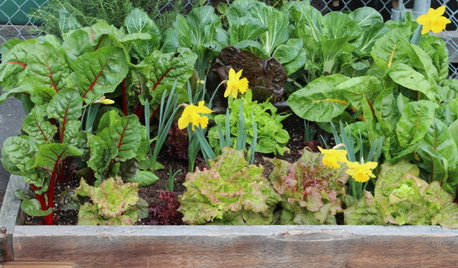CRW tomato cage question
bookjunky4life
12 years ago
Related Stories

EDIBLE GARDENSSummer Crops: How to Grow Tomatoes
Plant tomato seedlings in spring for one of the best tastes of summer, fresh from your backyard
Full Story
FARM YOUR YARDHouzz Call: Home Farmers, Show Us Your Edible Gardens
We want to see where your tomatoes, summer squashes and beautiful berries are growing this summer
Full Story
FARM YOUR YARDHow to Build a Raised Bed for Your Veggies and Plants
Whether you’re farming your parking strip or beautifying your backyard, a planting box you make yourself can come in mighty handy
Full Story
EDIBLE GARDENSHow to Grow Your Own Sweet Summer Crops
This guide will help any gardener get started on growing the freshest warm-season veggies and berries for summer
Full Story
FARM YOUR YARDHow to Grow Vegetables in Containers
Get glorious vegetables and fruits on your patio with a pro’s guidance — including his personal recipe for potting mix
Full Story
FARM YOUR YARDGrow a Kitchen Garden in 16 Square Feet
Got a sunny 4-by-4 space? You can make meals more interesting with your own vegetables and herbs
Full Story
THE ART OF ARCHITECTUREWorld of Design: Trees Bring Nature to a High-Rise in Milan
Discover ‘the most beautiful and innovative skyscraper in the world’ — the foliage-filled Bosco Verticale — and tour one of its apartments
Full Story
PETS6 Ways to Help Your Dog and Landscape Play Nicely Together
Keep your prized plantings intact and your dog happy too, with this wisdom from an expert gardener and dog guardian
Full Story
LIFEHow to Outsmart Backyard Critters
Learn to think like a raccoon, skunk or squirrel to keep your home safe and your garden intact
Full Story







mrs.b_in_wy
bookjunky4lifeOriginal Author
Related Professionals
Arlington Landscape Architects & Landscape Designers · Middle River Landscape Architects & Landscape Designers · Richmond Heights Landscape Architects & Landscape Designers · Forest City Landscape Architects & Landscape Designers · Edmond Landscape Contractors · Arlington Landscape Contractors · Essex Landscape Contractors · Gainesville Landscape Contractors · Little Ferry Landscape Contractors · Paso Robles Landscape Contractors · Hainesport General Contractors · Northfield General Contractors · Pittsburgh Decks, Patios & Outdoor Enclosures · Redlands Decks, Patios & Outdoor Enclosures · Stafford Decks, Patios & Outdoor Enclosureswertach zone 7-B SC
John A
bookjunky4lifeOriginal Author
bookjunky4lifeOriginal Author
schrebergaertner
tomakers
bookjunky4lifeOriginal Author
Bob_B
bookjunky4lifeOriginal Author
mrs.b_in_wy
tomakers
bookjunky4lifeOriginal Author
tomakers
buenaventura43
bookjunky4lifeOriginal Author
wertach zone 7-B SC
bookjunky4lifeOriginal Author
wertach zone 7-B SC
coconut_head
wertach zone 7-B SC
bookjunky4lifeOriginal Author
wertach zone 7-B SC
tomakers
tdscpa
bookjunky4lifeOriginal Author
quiltsrcool
tdscpa
wertach zone 7-B SC
nil13
digdirt2
Love Nature